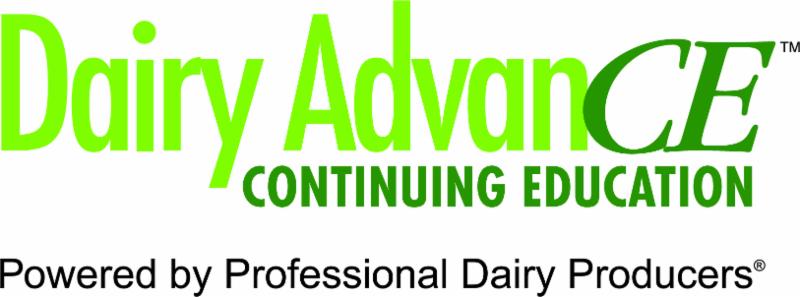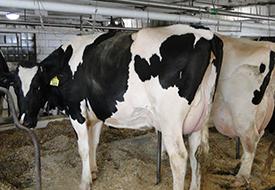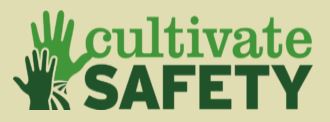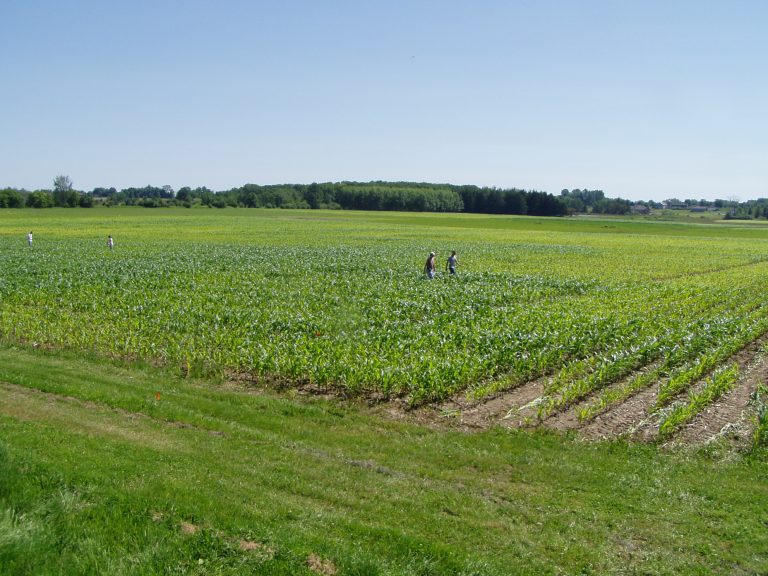|
Brought to you by Dairy's Professional Development Organization®
|
|
Opportunities to learn...
 WHAT'S IT TAKE TO MAKE A BUCK DAIRYING?
That'll be the focus of PDPW Wisconsin Dairy Tours on July 17 in the northwestern part of the state. An in-depth roundtable discussion will be bookended by tours to Son-Bow Farms near Spring Valley and Alfalawn Farm near Menomonie. Financial consultants Dave Becker, founding partner of Dairy Business Consulting Group, and Steve Bodart, Senior Dairy Consultant with Compeer Financial will cut to the heart of dairy management in today's dairy climate by discussing key factors all dairies can control. Participants will see Son-Bow's nutrient management system which includes reclaiming water, separating solids and composting sand bedding; at Alfalawn attendees will get a closer look at 60-cow rotary parlor and learn more about the strategies they've implemented to prepare for the potential of the next generation stepping in. Come prepared to ask questions of the host farm owners and managers, and other dairy professionals as you identify opportunities to improve productivity and sustainability on your farm.
To learn more about the program and
to register
, visit www.pdpw.org or contact PDPW at 800-947-7379. WHAT'S IT TAKE TO MAKE A BUCK DAIRYING?
That'll be the focus of PDPW Wisconsin Dairy Tours on July 17 in the northwestern part of the state. An in-depth roundtable discussion will be bookended by tours to Son-Bow Farms near Spring Valley and Alfalawn Farm near Menomonie. Financial consultants Dave Becker, founding partner of Dairy Business Consulting Group, and Steve Bodart, Senior Dairy Consultant with Compeer Financial will cut to the heart of dairy management in today's dairy climate by discussing key factors all dairies can control. Participants will see Son-Bow's nutrient management system which includes reclaiming water, separating solids and composting sand bedding; at Alfalawn attendees will get a closer look at 60-cow rotary parlor and learn more about the strategies they've implemented to prepare for the potential of the next generation stepping in. Come prepared to ask questions of the host farm owners and managers, and other dairy professionals as you identify opportunities to improve productivity and sustainability on your farm.
To learn more about the program and
to register
, visit www.pdpw.org or contact PDPW at 800-947-7379.

REGISTER TODAY FOR JULY AGRICULTURAL PROFESSIONAL PARTNERSHIPS® TRAINING. Industry professionals with limited on-farm experience have an opportunity to learn firsthand from top-notch farmers during on-farm tours and classroom learning at the July 24-26 Agricultural Professional Partnerships (APPs) trainings. Back by popular demand, participants will learn about animal care practices, environmental stewardship techniques, employee management, the economics of production agriculture and more. Attendees will depart from Madison each day for the on-farm training at dairy farms in southern Wisconsin. To register, click here or call 800-947-7379.
FARM TOUR, ICE CREAM AND COMMUNITY DISCUSSIONS ARE ON TAP for the 2018 Agricultural Community Engagement On-the-Farm Twilight Meetings in August. These on-farm events bring together local community leaders and dairy producers to learn together and discuss important issues. Meetings begin with a one-hour tour of the host dairy from 6:00 to 7:00 p.m., followed by ice cream, discussion and a question-and-answer session open to all attendees. Events will be held:

- Mon., Aug. 27: Kellercrest Holsteins, 1141 County Highway JG South, Mt. Horeb, WI 53572
- Tue., Aug. 28: Miltrim Farms, 1715 W Townline Rd., Athens, WI 54411
- Wed., Aug. 29: Brey's Cycle Farm LLC, 2139 County Road O, Sturgeon Bay, WI 54235
- Thu., Aug. 30: Double S Dairy, N3447 Marshview Rd., Markesan, WI 53946
These are FREE community events, for additional information, click
here
, call 800-947-7379 or email mail@pdpw.org.

CHECK OUT DAIRY ADVANCE
- If you've earned continuing education credits by attending accredited
programs offered by PDPW or another education provider, be sure to manage
your credits at www.DairyAdvanCE.org. Setting up an account through this award-winning system
is easy (and FREE for farmers).
Dairy AdvanCE allows subscribers to find, track and report Continuing Education (CEs) units from your mobile device or desktop computer at any time
.
To track or report your CEs - or for more details click here .
|
For your dairy...

DAIRY CALF LUNG CONSOLIDATION CAN DECREASE
first-lactation milk production, according to research published in the Journal of Dairy Science. Lung consolidation occurs when lung tissue has filled with liquid instead of air, resulting in swelling or hardening of the normally soft tissue. In this study, researchers used thoracic ultrasonography to detect bovine respiratory disease in 214 female dairy calves from three herds, then tracked health and performance through first lactation. The results concluded the presence of lung consolidation detected by ultrasound at least once in the first eight weeks of life did not influence age of first calving but did result in a decrease of 1157 pounds in first-lactation milk production. Read more about the study and findings
here
.
 ARE YOU OVER- OR UNDER-MILKING? While traditional recommendations have been to milk cows as completely as possible at each milking, new research is showing today's cows have higher alveolar capacity, are more efficient milk producers and can never be completely milked out. As a result, overmilking can lead to hyperkeratosis and teat-end health problems. A quick strip-yield test can be conducted either by hand or machine to see whether overmilking is a problem on your farm. Click here
to see instructions on conducting this test from Penn State Extension. According to the article, a properly milked cow should have about one cup of milk left in the udder after the milking unit comes off. ARE YOU OVER- OR UNDER-MILKING? While traditional recommendations have been to milk cows as completely as possible at each milking, new research is showing today's cows have higher alveolar capacity, are more efficient milk producers and can never be completely milked out. As a result, overmilking can lead to hyperkeratosis and teat-end health problems. A quick strip-yield test can be conducted either by hand or machine to see whether overmilking is a problem on your farm. Click here
to see instructions on conducting this test from Penn State Extension. According to the article, a properly milked cow should have about one cup of milk left in the udder after the milking unit comes off.
 SUSCEPTIBILITY TO CLINICAL MASTITIS CAN BE IDENTIFIED with a new blood test developed by Oregon State University researchers, according to research published in the Journal of Dairy Science. The study included 161 healthy pregnant Holstein cows from a 1,000-head dairy farm. Blood samples were collected weekly during the last three weeks before calving and again at calving. After calving, researchers compared blood samples of eight cows that were diagnosed with clinical mastitis but no other diseases after calving with nine cows that remained healthy after calving. They used ultra-performance liquid chromatography high-resolution mass spectrometry to analyze the blood samples for lipids and other circulating metabolites. Study authors said this test could make it possible for a farmer to determine which cows are at risk before infection occurs. Learn more in the study. SUSCEPTIBILITY TO CLINICAL MASTITIS CAN BE IDENTIFIED with a new blood test developed by Oregon State University researchers, according to research published in the Journal of Dairy Science. The study included 161 healthy pregnant Holstein cows from a 1,000-head dairy farm. Blood samples were collected weekly during the last three weeks before calving and again at calving. After calving, researchers compared blood samples of eight cows that were diagnosed with clinical mastitis but no other diseases after calving with nine cows that remained healthy after calving. They used ultra-performance liquid chromatography high-resolution mass spectrometry to analyze the blood samples for lipids and other circulating metabolites. Study authors said this test could make it possible for a farmer to determine which cows are at risk before infection occurs. Learn more in the study.
|
 ONE-THIRD OF AMERICANS ARE ON A DIET
or following a specific eating pattern, according to the
13th Annual Food and Health Survey
, released recently by the International Food Information Council Foundation. The top diet plan was intermittent fasting, with 10% of respondents following that pattern. Diets considered at least somewhat carbohydrate-restrictive were well-represented, including Paleo (
7%), low-carb (5%), Whole 30 (5%), high-protein (4%), and ketogenic/high-fat (3%). Respondents also reported higher instances of avoiding sugar. The survey also found consumers 18 to 34 years old were more likely to follow a specific eating pattern or diet than those 35 years old and older. ONE-THIRD OF AMERICANS ARE ON A DIET
or following a specific eating pattern, according to the
13th Annual Food and Health Survey
, released recently by the International Food Information Council Foundation. The top diet plan was intermittent fasting, with 10% of respondents following that pattern. Diets considered at least somewhat carbohydrate-restrictive were well-represented, including Paleo (
7%), low-carb (5%), Whole 30 (5%), high-protein (4%), and ketogenic/high-fat (3%). Respondents also reported higher instances of avoiding sugar. The survey also found consumers 18 to 34 years old were more likely to follow a specific eating pattern or diet than those 35 years old and older.
PROTECTING YOURSELF AND YOUR FARM FROM UNDERCOVER VIDEOS
continues to be at on the minds of dairy producers as animal activist groups continue to release images from videos shot on farms. Preventing video footage from being captured on your farm starts with clear protocols on animal handling and care practices and open communications with employees to report unacceptable behavior. Unfortunately, even with protocols in place, video footage can be edited or mishandled to appear negative. A Farm Journal's MILK article provides tips on protecting your farm: 
- Ask questions and conduct reference checks
- Have an employee contract in place
- Visit the online site "See It Stop It"
- Dedicate yourself to continuous improvement
- Be in the barn
- Look at things with a consumer's eye
- Make deposits in your "credibility bank" before a crisis
Read the full article
here
.
 PAY ATTENTION TO SAFETY FOR FARM PLAY AREAS, TOO.
Summer break is here, and that means kids will be playing outside. The farm offers lots of great areas to play, but also a number of potential hazards and dangers to young children. In fact, the highest rate of injuries for children younger than 10 years old on farms happened while children were playing in the worksite. Some guidelines from the National Children's Center for Rural and Agricultural Health & Safety for safe on-farm play areas include that the area should be: PAY ATTENTION TO SAFETY FOR FARM PLAY AREAS, TOO.
Summer break is here, and that means kids will be playing outside. The farm offers lots of great areas to play, but also a number of potential hazards and dangers to young children. In fact, the highest rate of injuries for children younger than 10 years old on farms happened while children were playing in the worksite. Some guidelines from the National Children's Center for Rural and Agricultural Health & Safety for safe on-farm play areas include that the area should be:
- Designated by boundaries or physical barriers such as fences, gates or shrubs
- Away from car, truck and other vehicle traffic
- Away from hazards such as machinery or unstable structures (such as a tractor tire leaning against a building)
- Free from open water - children can drown in as little as 2 inches of water
- Adequately shaded from sun and sheltered from wind, dust or hazardous airborne particles
See the full list of guidelines and more tips
here
.
|
For your business mind...
 MANAGING PEOPLE, NOT ASSETS, IS STILL KEY to the success of dairy operations, according to research published in the Journal of Dairy Science. Researchers interviewed managers as well as employees from 12 dairies with 500 or more cows to identify strengths and weaknesses of the farms based on employee perceptions and to investigate how perceptions of employees and managers differ. Key issues identified as important by employees were performance feedback (particularly positive feedback), open and honest communication with the supervisor, training, and communication of goals. Despite some differences between English-speaking and Latino employees, similarities in responses were greater. When employers were surveyed on how they thought their employees would answer, they underestimated employee responses on several questions, in particularly the level interest they thought employees had in learning more about dairy. Though employees gave high ratings to their commitment to the farm and their interest in learning, when taking employee turnover into account there was an obvious disparity between reality and ideal employee management. Read the full study here. MANAGING PEOPLE, NOT ASSETS, IS STILL KEY to the success of dairy operations, according to research published in the Journal of Dairy Science. Researchers interviewed managers as well as employees from 12 dairies with 500 or more cows to identify strengths and weaknesses of the farms based on employee perceptions and to investigate how perceptions of employees and managers differ. Key issues identified as important by employees were performance feedback (particularly positive feedback), open and honest communication with the supervisor, training, and communication of goals. Despite some differences between English-speaking and Latino employees, similarities in responses were greater. When employers were surveyed on how they thought their employees would answer, they underestimated employee responses on several questions, in particularly the level interest they thought employees had in learning more about dairy. Though employees gave high ratings to their commitment to the farm and their interest in learning, when taking employee turnover into account there was an obvious disparity between reality and ideal employee management. Read the full study here.
 DETERMINING AMOUNT OF NITROGEN LOSS and whether additional nitrogen application is needed is top-of-mind for many growers facing wet conditions. A University of Wisconsin Extension article outlines how to determine if nitrogen loss from excessive rainfall has occurred and which corrective measures may be taken. The first step is to determine how much of the applied nitrogen may be nitrate - this is the form of nitrogen that can be lost via leaching or denitrification. Soil texture and drainage, form of nitrogen applied, duration between applications and heavy rain events are all factors to consider. Click here for the full article with details on measuring nitrogen loss and recommendations for supplemental application. DETERMINING AMOUNT OF NITROGEN LOSS and whether additional nitrogen application is needed is top-of-mind for many growers facing wet conditions. A University of Wisconsin Extension article outlines how to determine if nitrogen loss from excessive rainfall has occurred and which corrective measures may be taken. The first step is to determine how much of the applied nitrogen may be nitrate - this is the form of nitrogen that can be lost via leaching or denitrification. Soil texture and drainage, form of nitrogen applied, duration between applications and heavy rain events are all factors to consider. Click here for the full article with details on measuring nitrogen loss and recommendations for supplemental application.
 TACKLING THE TOUGHEST TASK FIRST
may not always be the best approach to starting your workday off well. The popular saying "Eat a frog first thing in the morning and nothing worse will happen to you the rest of the day" advises tackling projects that have high impact. Generally these tasks aren't the easiest or most appealing. However,
this article
makes the case that sometimes it is better to start the day by accomplishing several small tasks. It further suggests some office environments aren't suited to highest productivity immediately upon arrival. The author shares several strategies for deciding when to "eat that frog" on your to-do list. TACKLING THE TOUGHEST TASK FIRST
may not always be the best approach to starting your workday off well. The popular saying "Eat a frog first thing in the morning and nothing worse will happen to you the rest of the day" advises tackling projects that have high impact. Generally these tasks aren't the easiest or most appealing. However,
this article
makes the case that sometimes it is better to start the day by accomplishing several small tasks. It further suggests some office environments aren't suited to highest productivity immediately upon arrival. The author shares several strategies for deciding when to "eat that frog" on your to-do list.
|
"If your actions inspire others to dream more, learn more, and become more, you are a leader."
--- John Quincy Adams
|
Book review...

HBR'S 10 MUST-READS ON MANAGING YOURSELF
This collection of best-selling articles from the Harvard Business Review features viewpoints and research to help business owners identify their greatest strengths and deepest values and stay engaged and productive throughout their working life. The book includes essays titled "How Will You Measure Your Life?" by Clayton M. Christensen, "Managing Oneself," "Management Time: Who's Got the Monkey?," "How Resilience Works," "Manage Your Energy, Not Your Time," "Overloaded Circuits: Why Smart People Underperform," "Be a Better Leader, Have a Richer Life," and more. Learn more
here
.
|
|
A BIG Thank You...
TO THE PDPW SPONSORS who are supporting your professional development organization! As a producer-led group,we extend a heart-felt "Thank You!" to those that stand alongside our nation's dairy farmers. T
heir support allows PDPW to execute best-in-class producer training and has enabled us to become the go-to resource for unified outreach initiatives. If you or a company you know is interested in participating as a sponsor, please contact us at abonomie@pdpw.org or call 800-947-7379.
See the full list of generous sponsors
here.
|
|
PDPW Education Calendar
| July 17 |
Wisconsin Farm Tours: Marshfield & Eau Claire, Wis. |
| July 24-26 |
PDPW APPs Training for Non-Farm Professionals: Madison, Wis.
|
| August 27-30 |
PDPW ACE On-the-Farm Twilight Meetings: Mt. Horeb, Athens, Sturgeon Bay & Markesan, Wis.
|
| Jan. 15-17, 2019 |
2019 PDPW Managers Academy for Dairy Professionals: South Carolina
|
| Mar. 13-14, 2019 |
2019 PDPW Business Conference: Madison, Wis.
|
STAY CONNECTED
800-947-7379
|
|
|
|
|